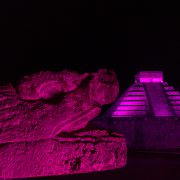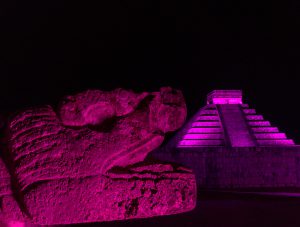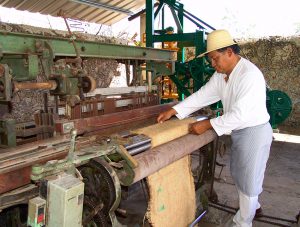You’ll want to spend many of your days on the beach at Grand Residences or snorkeling the Mesoamerican Reef that is right on your doorstep, but when the spirit of wanderlust takes you and you are ready to go exploring here are three trip ideas and your Concierge will have many more unforgettable travel adventures in store for you.
Chichen Itza by night
Have you ever experienced the mystery of Chichen Itza after dark? The sounds of the jungle, a clear sky filled with stars and the sight of ancient temples and stone masks illuminated by moonlight are unforgettable and on top of that, the Kukulcan Nights Light Show is amazing.
Take an afternoon trip to Chichen Itza and explore at your leisure, enjoy an early dinner and return to the ancient city in the evening to see the Kukulcan Nights 3D video mapping show. The temples in the Great Plaza are illuminated in different colors and the Pyramid of Kukulcan is the backdrop for the tale of the Maya creation story.
If you want to explore Chichen Itza at your own pace, why not rent a car and visit the colonial town of Valladolid en route? You could also visit some of the cenotes or sinkholes that pepper the landscape of the eastern Yucatan. Zaci, Dzitnup, Samula and Hubiku in the Valladolid area are all popular, as is Ik-Kil, which is a short distance from Chichen Itza. Another option is to tour the smaller archaeological site of Ek Balam in the morning. It’s only 20 minutes to the north of Valladolid so you can return there for lunch before setting off for Chichen Itza in the afternoon.
Spend the day in Akumal
A perennial Riviera Maya family favorite, Akumal is a picture-perfect beach dotted with palm trees. The bay is protected by a coral reef and the shallow waters are calm and crystal-clear, making it an ideal spot to take children.
Spend the day building sand castles with the children – Mayan pyramids, fish and turtles are all popular subjects – and snorkeling in the bay. You’ll see a variety of colorful fish and you may even see one of the turtles that gives this idyllic spot its name. In the Maya language Akumal means “place of the turtles.”
Shop for Mexican crafts, textiles, jewelry and evocative pictures of Akumal and its sea turtles by a local painter in the stores and galleries clustered under the palm trees a short walk from the bay.
If you are feeling hungry, fresh seafood, shrimp tacos, tasty salads, sandwiches, homemade cakes and ice cream are all on the menu.
A short drive along the coast road to the north of Akumal beach is Half Moon Bay, a cove where the reef comes closer to the shore. The snorkeling is good here too and the views just as beautiful. There’s a funky tropical beach bar with swings, hammocks, thatched lookout towers and tables and benches made of tree trunks. Order a cocktail and enjoy the view. The water is so clear that you can sometimes see turtles coming up for air and rays and parrotfish swimming in the shallows.
Follow the coast road further north to the shores of Yalku, a turquoise-colored inlet of crystal-clear waters constantly replenished by cenotes and underground rivers, hence the refreshingly cool temperature.
A variety of colorful reef fish feed and breed among the mangrove roots and submerged rocks in the lagoon. You’ll be surrounded by inquisitive sergeant majors as soon as you enter the water. Don your mask and start swimming and you’ll soon spot blue tangs, butterfly fish, angelfish and pork fish, among others.
A local cooperative manages Yalku and charges a fee for admission. Life jackets are available and there are restrooms and a little open-air cafe.
Visit the haciendas of the Yucatán
Travel back in time to the late 19th century and learn about henequen, the native agave that fuelled an economic boom in Yucatan so extraordinary that the miracle plant became known as “green gold.” It yielded a tough fiber used to make rope and sacking and for which international demand soared with agricultural mechanization. Fortunes were made overnight as Yucatan’s hacienda owners scrambled to turn more acreage over to the cultivation of the lucrative crop.
One way of learning more about the area’s henequen heritage is to take a trip that combines a hacienda visit with a tour of Merida. During the henequen boom, the city is said to have been home to more millionaires than any other city in the world. You can still see the opulent mansions of the henequen barons on Paseo Montejo, the boulevard inspired by the Champs Elysées in Paris and the impressive civic landmarks, such as the Peon Contreras Theater that they commissioned.
The second leg of this journey takes you to Hacienda Sotuta de Peon, a working henequen estate 28 miles (35 kilometers) south of the city in Tecoh district (take the turn off after the village of Itzincab) along the Convent Route.
The Sotuta visit includes a ride out to the fields in a traditional horse-drawn wagon or “truck” to see how henequen is planted and harvested. Workers in the machine house show visitors how the leaves were shredded to extract the fiber, dried and combed before being woven into rope and twine and used to make bags and mats. In the 19th century, the fiber was packed into bales to be transported by rail to the Gulf coast port of Sisal where it was shipped overseas.
Visitors can also walk through the restored rooms of the estate house still decorated with the original furniture, French porcelain, crystal and art; see a traditional Mayan home and swim in the crystalline waters of the Dzul-Há Cenote.
Another hacienda that you can visit on your own without taking a tour is Hacienda Teya, eight miles (12.5 km) from the city of Merida on Highway 180.
Founded in 1683, Teya was a cattle and corn estate. Unusually for the era, the owner was a woman, Ildefonsa Antonia Marcos Bermejo Calderón y de la Helguera, the wife of the Conde de Miraflores.
Teya was turned over to henequen in the nineteenth century and its prosperous owners enhanced the colonial estate house with neo-Classical-style features, which were even incorporated in the outhouses, especially the machine house.
By the 1970s, Teya was deserted, derelict and on the market. A Merida businessman, Jorge Carlos Cárdenas Gutiérrez went to see the property in 1974 and fell in love with it. He bought it and painstakingly began to restore the orchards and gardens with his family, finally starting on the house and other buildings in 1985.
Famous for its restaurant serving Yucatecan cuisine, Teya is also a popular setting for weddings, conventions and other special events. It has two chapels, rooms for cocktails and banquets and beautiful gardens. A swimming pool by day, the 1905 machine house is transformed into a magnificent ballroom for evening events.
For assistance in arranging all your trips in the Mexican Caribbean and the state of Yucatan ask your Concierge.







